Having A Baby? Here Are the Carseat Basics You Need to Know
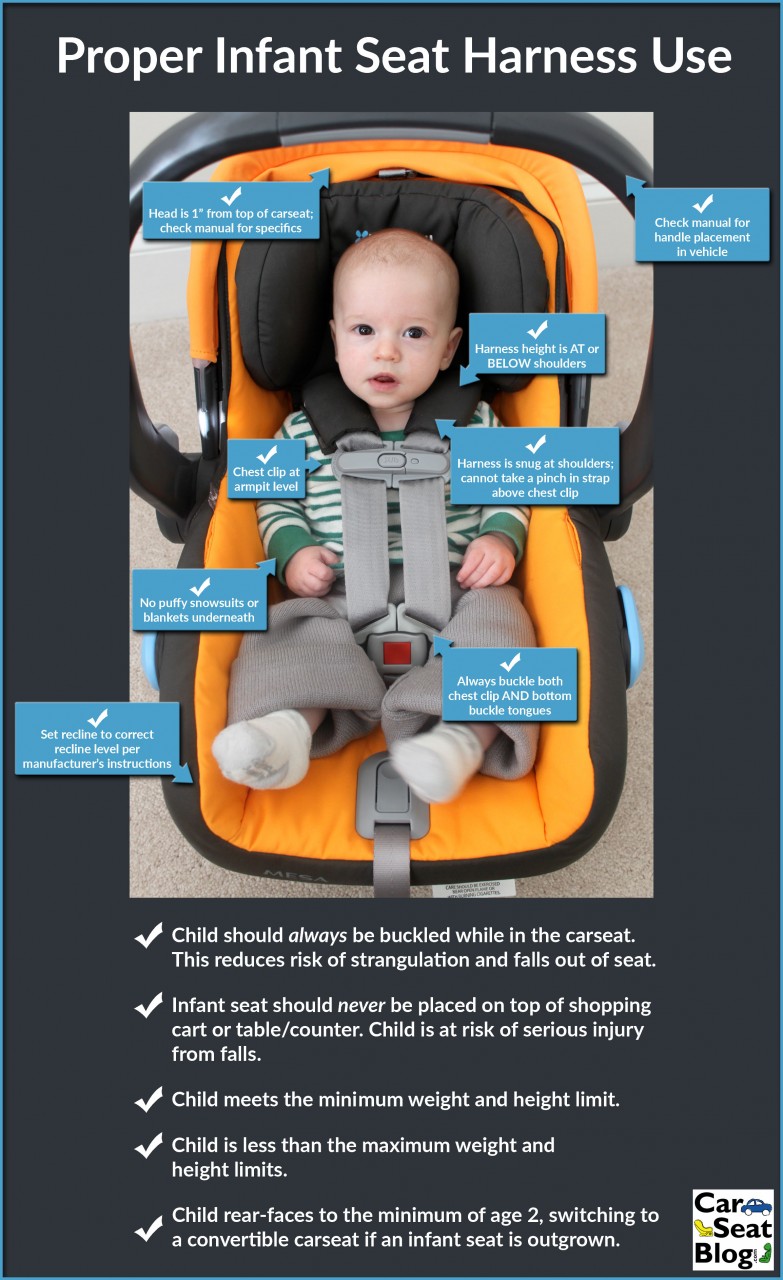
![]()
![]()
![]()
![]()
![]()
Carseat 101: Answering Your New Parent Carseat Questions
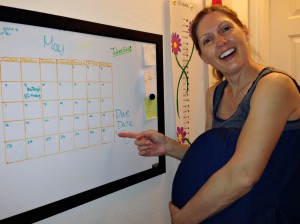 You’ve peed on the stick and found out you’re pregnant. Yay! (Or not. Who am I to say?) You’ve gone to Target, buybuyBaby, and Amazon.com and registered for every single baby item under the sun that’s plastic and can be sanitized and trust me, it all coordinates, right? Now you’ve come down to the final weeks and it’s panic time when you realize this baby is coming out one way or another and you have to get it home. You just stick Baby in the carseat and go, right? No. Nope. No way, new parent. You are now attending Carseat 101 and there will be a quiz at the end. I have no doubt you will pass with flying colors!
You’ve peed on the stick and found out you’re pregnant. Yay! (Or not. Who am I to say?) You’ve gone to Target, buybuyBaby, and Amazon.com and registered for every single baby item under the sun that’s plastic and can be sanitized and trust me, it all coordinates, right? Now you’ve come down to the final weeks and it’s panic time when you realize this baby is coming out one way or another and you have to get it home. You just stick Baby in the carseat and go, right? No. Nope. No way, new parent. You are now attending Carseat 101 and there will be a quiz at the end. I have no doubt you will pass with flying colors!
First, let’s go over some vocab you’ll need for the next, oh, decade or so. Yeah, baby, your precious is going to be in a seat for a loonngg time. In chronological order, please:
Rear-facing only infant seat:
This carseat is used for newborns to sometimes toddlerhood. It’s easily identified by its handle, canopy, and left-in-the-car base. The carrier portion fits onto the base.
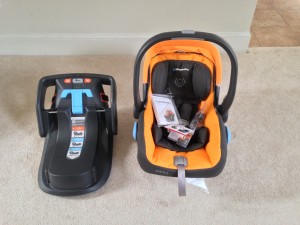

Convertible seat:
This carseat can be used for newborns, but is often used after a child outgrows a rear-facing only seat. It rear-faces, then converts to forward-facing for older kids.

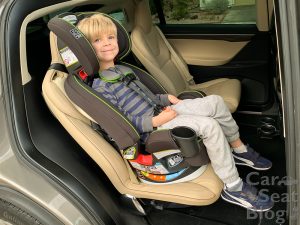
Combination (harness-to-booster) seat:
This carseat is for older kids, the kind who order combo meals at fast food restaurants (and yes, you too, will succumb to buying your child a grease-loaded meal item at some point). A combo seat FORWARD-FACES ONLY. It has a harness to keep wiggly kids safe, then the harness comes off (many store on the seat itself now) and it can be a belt-positioning booster. See why it’s for older kids only? It combines a harness and a booster into one seat (see what I did there?). You don’t always need a combo seat. Sometimes your child can go straight from a convertible seat to a belt-positioning booster, depending on which convertible she uses and how old and big she is.
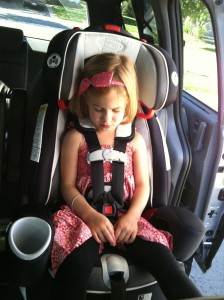

Belt-positioning booster seat:
This carseat is for kids who nearly have gray hair. Just kidding. Barely. The purpose of a booster seat is to boost a kid up higher so that the vehicle’s lap and shoulder belt will fit them superbly over their bones, not their soft bellies. Kids have to have a certain amount of maturity in order to sit still in a vehicle seat belt and that comes around ages 4-6, depending on the child. Most parents find their kids transitioning out of a harness around ages 5-6, when “real” school starts, not that “pre-“ stuff. There are highback and backless varieties of boosters. Highbacks are great for the younger crowd because they provide head and torso support for sleeping. Backless boosters are harder to see from outside the car, so older, image-conscious kids like them better. Kids use booster seats until they can 5-step—fit in the belt like an adult—which is when they get to be the size of a small adult, around age 10-11.


Let’s identify that you’ve gotten the right carseat for you. It used to be that an infant seat was an infant seat was an infant seat. Basically, all the carriers did more or less the same thing—it was the bases that distinguished them. Now we have carriers that fit small babies very well, some that don’t, some that have no-rethread harnesses, some that have canopies that disappear, and some that you can sling around your shoulders. There’s quite a variety from which to choose and that can cause more confusion than ever! What’s my very first piece of advice to you in this area? Don’t insist on a travel system. Pick the very best rear-facing only seat that will work for you, then pick the very best stroller you can afford and put them together. Many strollers come with adapters and with a little bit of research on their website, you can find if the infant seat you want will fit on the stroller you want. The patterns may not match perfectly, but you will get a much better stroller this way usually unless you buy a high-end infant seat/stroller combo to begin with. I speak from experience: you don’t want to be stuck with a stroller you hate for years because you wanted to be all matchy-matchy with an infant seat you use for months. To help you in your search, we have both thorough, professional reviews and a list of our favorite seats.
Most of the time you will know if you’re going to have a small, average, or large baby by the end of your 40 weeks. If you and your partner are small folks and come from small families, genetics won’t let you down. Look for a rear-facing only seat that starts with a low birth weight of 4 lbs. It’s the same if you’re having a difficult pregnancy or if you’re having multiples. Fortunately, there are lots of rear-facing only seats that now have a minimum weight limit of 4 lbs., but they don’t always fit the preemie-sized babies well. We have a list of our favorite seats that fit preemies and multiples. If you’re having an average- or large-sized baby, any infant seat will do, though you’ll get more bang for your buck with a larger one. The size of your vehicle also has to be factored in since the larger the infant seat, the more space it takes up in the vehicle.
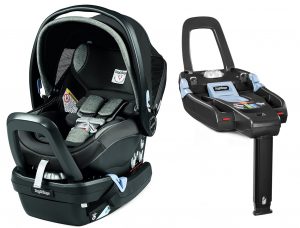
Now for some answers to common questions:
When to Install the Carseat?
About 3-4 weeks before your due date, you’ll want to install your carseat.
Don’t wait for the last minute to do this because I’ll let you in on a little secret: you’ve had at least 6 months to plan for this big event unless you belong on a reality TV show. Making a panicked appointment the day before you’re due to try to learn how to use your carseat is like cramming for the SAT when you haven’t studied at all. I know your priority will be to make sure your baby arrives home safely; you won’t be caring about whether or not the blankets match at that point. If you try to install it yourself first, the base should move less than 1” if you’re using a rear-facing only seat and no, you can’t use both LATCH and the seat belt at the same time*. If you’re using a convertible seat, it should move less than 1” if you tug at the rear-facing belt path.
*Unless you have the Nuna Pipa.
Can I Go to the Fire Station to Get My Carseat Installed?
I’m going to say no on this one. Most firefighters and police officers are NOT trained to install carseats properly, contrary to popular belief. But they are awfully helpful, aren’t they? That doesn’t make up for proper training, unfortunately. Getting the wrong information could be very dangerous and you don’t want to gamble your child’s life on that. Make sure to visit a certified child passenger safety technician by visiting a checkup event or by making an appointment with one. Sometimes you’ll find an inspection station at a firehouse. An inspection station has regular hours when a technician is on hand to help you with your carseat. http://cert.safekids.org/get-car-seat-checked
Recline Recline Recline
 We emphasize the proper recline angle for small babies, especially newborns, because of airway concerns. If a baby’s chin falls to her chest, her airway will be cut off and she’ll suffocate. It’s a very real concern when dealing with carseats, so we’re quite serious that we get the angle just right. However, we also have our hands tied because we must follow manufacturers’ instructions on how reclined we can make a seat since manufacturers crash test their carseat recline angles. Usually there’s a range in the indicator and we can finesse the angle to be the best for your baby, but sometimes based on the carseat and your vehicle seat, we have to try a new seat. I know it’s disappointing to hear the dreaded, “This isn’t going to work in your vehicle,” but we only have the best intentions for your child in mind (and this is another reason why it’s important not to wait until the last minute to install your carseat!). The most important thing to remember is that we don’t want baby’s head to fall forward—off to the side is OK, but not forward. And to be honest, it’s been a very rare situation where I’ve had to break the news to a parent that a carseat just doesn’t work for them.
We emphasize the proper recline angle for small babies, especially newborns, because of airway concerns. If a baby’s chin falls to her chest, her airway will be cut off and she’ll suffocate. It’s a very real concern when dealing with carseats, so we’re quite serious that we get the angle just right. However, we also have our hands tied because we must follow manufacturers’ instructions on how reclined we can make a seat since manufacturers crash test their carseat recline angles. Usually there’s a range in the indicator and we can finesse the angle to be the best for your baby, but sometimes based on the carseat and your vehicle seat, we have to try a new seat. I know it’s disappointing to hear the dreaded, “This isn’t going to work in your vehicle,” but we only have the best intentions for your child in mind (and this is another reason why it’s important not to wait until the last minute to install your carseat!). The most important thing to remember is that we don’t want baby’s head to fall forward—off to the side is OK, but not forward. And to be honest, it’s been a very rare situation where I’ve had to break the news to a parent that a carseat just doesn’t work for them.
Which Harness Slots Should I Use?
Use the harness slots closest to and below baby’s shoulders.
Newborns typically use the lowest harness slots on their carseats. On some infant seats that fit preemies well, those bottom harness slots are really low and a large newborn might use the next slots up. How can you tell which slots to use? For any rear-facing carseat, use the harness slots that are at or below the child’s shoulders. So for the next several years, you’ll be setting the harness at or below your child’s shoulders. What this means is that before you leave the hospital (or wherever you gave birth), you should set the baby in the carseat and see where his shoulders are in relation to the harness slots. The easy way to set the baby in is to have one hand under the bum and another supporting the baby’s neck. Then gently scooch your hands out. This way you can make sure the baby’s bum is all the way against the back of the carseat and his back is relatively straight. You don’t want a slouchy baby in a carseat. Use the harness slots closest to and below baby’s shoulders.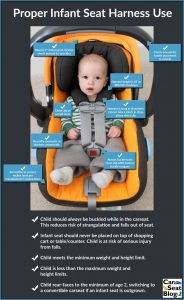
How Tight Should the Harness Be?
Harness should be snug as a hug and you shouldn’t be able to take a pinch
Most parents don’t snug up the harness enough on a newborn because they’re afraid they’re going to hurt the little squishy. Plus, it’s dang hard to put a harness on a newborn because they tend to ball up like puppies. Here’s what I tell every parent of a newborn: newborns are used to cramped, tight spaces and they love feeling secure. Imagine what it’s like to not have a secure harness on when you’re being swung around in an infant seat? The harness should be snug like a hug on them so you can’t take a pinch above the chest clip. If you can pinch above the chest clip, give the harness adjuster strap between his legs another quick tug. If your carseat doesn’t come with harness strap covers and you think the straps are bothering your child’s neck, pull his shirt up a bit. It’s a simple, effective solution.
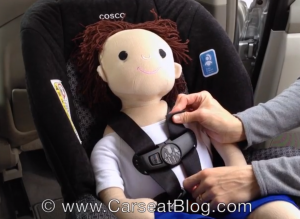
How Long Does the Infant Seat Fit?
Anywhere from 4 months-2 years
It all depends on the rear-facing only seat you bought to your child’s growth rate to your family’s genetics. There are still some infant seats that are on the small side and hold babies to only 22 lbs. That may sound big to you right now, but both of my kids were 22 lbs. by 5 months old! Most kids generally outgrow that rear-facing only seat by height before weight. There are also rear-facing only seats that can hold children to 35 lbs. and some kids can last in those seats until around age 2. Keep in mind that carseats also have an expiration date. Yep, the plastic goes bad after a certain number of years, depending on what plastic conditioners each manufacturer uses. If you think about it, it’s kind of like milk. You wouldn’t give your kid spoiled milk, so don’t let him ride in a seat that’s too old either. Shudder.
What Comes After the Infant Seat?
A rear-facing convertible or all-in-one/3-in-1/4-in-1 seat
After the infant seat, your child will use a rear-facing convertible or all-in-one seat until that carseat is outgrown. A convertible/all-in-one both rear-faces then converts to forward-facing for older kids. NEVER TURN AND USE AN INFANT SEAT FORWARD-FACING. (Did I say that loud enough?) Convertible/all-in-one carseats don’t have removable bases like infant seats do: if they have a base, it’s permanently installed to allow the carseat to recline. A convertible/all-in-one also doesn’t have a handle and is left installed in the vehicle. Most families have one for each vehicle so they don’t have to move it back and forth between cars. It’s a bigger carseat to allow a toddler/preschooler to fit in it, yet it can take up less space than an infant seat. Why? Because it can be placed more upright when rear-facing for an older child who doesn’t need to worry about keeping an airway open. The American Academy of Pediatrics recommends rear-facing until the maximum limits of the rear-facing carseat are reached, but they don’t specify the type of carseat. We recommend rear-facing to the maximum limits of a convertible/all-in-one carseat, which is 40-50 lbs.
Why Does My Kid Have to Rear-Face for So Long?
I know your nephew was turned forward at age 1, but look at it this way: you’re a better parent than your sister is. Oh holy cow, I’m just kidding! No need to email me now. We know that the bones in your child’s neck are very different from yours and mine: they’re in pieces connected together by cartilage. Until the cartilage is replaced by bone, which is a gradual process that happens over a long time starting at around age 1, it’s a very real possibility that your child’s head could pull his spinal cord apart in a crash if he’s forward-facing too early. A rear-facing carseat protects and cradles the entire head, neck, and back and provided optimal protection in frontal and side impacts. Even in serious rear impacts, children in rear-facing carseats have minimal, if any, injury. Think of it this way: it’s generally pretty easy to fix a broken leg if it happens, but there’s no way to fix a spinal cord injury. Rear-facing provides the best protection against spinal cord injuries. And if you don’t believe me, believe the American Academy of Pediatrics who have been recommending rear-facing as the safest mode of transportation since 2002.
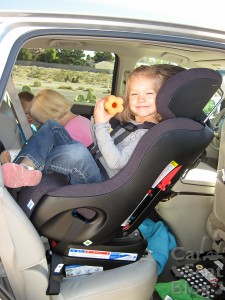
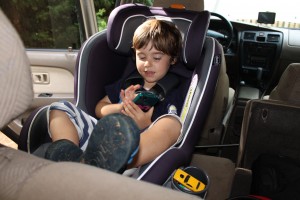

Quiz Time!
1.  What is a rear-facing only infant seat?
What is a rear-facing only infant seat?
a. A seat a baby sits in at a restaurant.
b. A portable carseat a child uses that has a handle and a base that stays in the car.
c. Something Darren’s cats sit in.
d. I like cheese.
2. How tight should the harness be?
a. I should tighten the harness to the point where I can only fit 2 fingers underneath.
b. I should pull the harness tight so I can only pinch 1” of harness.
c. I shouldn’t be able to pinch any harness webbing above the chest clip.
d. Dorrrrritos.
3. How long will my kid ideally be in a carseat?
a. Until he passes the 5-step test.
b. Until he meets our state law requirements.
c. Until the majority of his classmates in school are no longer in seats.
d. Gimme pie.
4. Which harness slots should be used on a rear-facing carseat?
a. Use the harness slots at or above the shoulders.
b. Use the harness slots at or below the shoulders.
c. Use the harness slots at the shoulders.
d. Yum yum gum.
5. Why is rear-facing so important?
a. It protects the head, neck, and back.
b. The American Academy of Pediatrics recommends it.
c. All of the above.
d. Mmmmm cheesecake
So, how’d you do on the quiz? Is this all I need to know?
Uh, hopefully you got 100% because this was an open-computer quiz ;). And this definitely is but a drop in the baby bucket of what you need to know about child passenger safety—in other words, keeping your child safe in a vehicle. You will be learning about carseats all throughout your child’s life. Did you realize that your child might be in a belt-positioning booster seat longer than any other carseat? Probably not, yet it’s the seat most parents want to spend the least amount of money on. Pretty twisted, huh? The key is to keep your mind open (and your partner’s, and that will be even harder 😉 ) and stay tuned to CarseatBlog. We’ll keep you informed on the latest news, recalls, safety items, and other issues bound to crop up along the way.
Quiz Answers: 1. b, 2. c, 3. a, 4. b, 5. c







